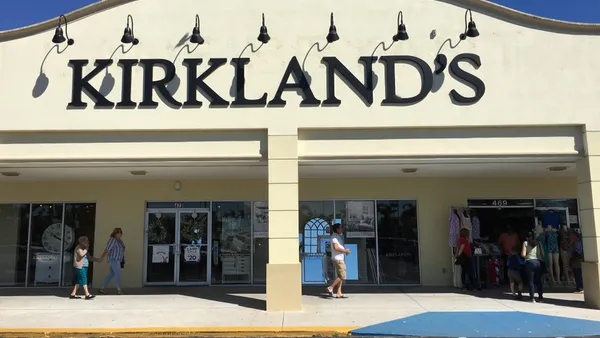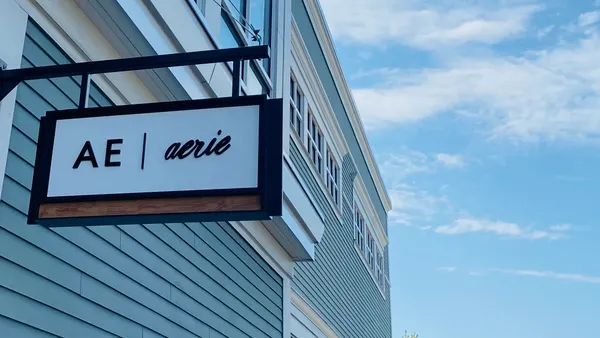UPDATE: August 7, 2019: Barneys later on Wednesday announced it had secured new financing of some $218 million from Brigade Capital Management, LP and B. Riley Financial, Inc., replacing the previously announced $75 million from Hilco Global and the Gordon Brothers Group. The added funds, plus the court’s interim approval granting access to $75 million of the new loan, (also announced Wednesday), will enable the department store to pay its vendors and employees "and conduct a sale process to position Barneys New York for the long-term," Barneys CEO Daniella Vitale said in a statement.
Dive Brief:
- Barneys New York on Monday said it has filed under Chapter 11 in the United States Bankruptcy Court for the Southern District of New York, in order "to use the court-supervised process to review store leases to best optimize the Company's operations and consider all value enhancing transactions."
- The department store also said it will close its: full-line stores in Chicago, Las Vegas and Seattle; five smaller concept stores; and seven Barneys Warehouse locations, according to a company press release. Five full-line locations — on New York City’s Madison Avenue and downtown, in Beverly Hills, San Francisco and at Copley Place in Boston — plus two Barneys Warehouse locations will remain open. Barneys.com and BarneysWarehouse.com will also continue "without disruption," the company said.
- Barneys said it has secured $75 million in new capital from affiliates of Hilco Global and the Gordon Brothers Group.
Dive Insight:
Barney's has a long history of seizing opportunity. The department store began as a discounter, but pivoted to luxury decades ago and has maintained its reputation for style despite the many challenges in the sector. Most recently, it joined the cannabis craze with its The High End concept in Los Angeles.
The department store already has plans to drastically scale back its footprint, and while an August bankruptcy filing can be awkward for any retailer preparing for the holidays, Chapter 11 isn't necessarily the end of it, according to Scott Stuart, CEO of Turnaround Management Association.
"What I would say is that Chapter 11 is a process and in the area of restructuring, you’re dealing with a living breathing thing, just like a patient is when a surgeon is operating," Stuart told Retail Dive in an interview. "Chapter 11 is not an end necessarily — it's supposed to be a mechanism to slow things down, and if time allows and if strategically there’s room to do a fix — it's not going to be a free-fall."
That's the note sounded in a statement by Barneys CEO Daniella Vitale. "For more than 90 years, Barneys New York has been an iconic luxury specialty retailer, renowned for its edit, strong point of view, creativity and representation of the world's best designers and brands," she said, adding, "Pursuing a sale under the Court's supervision provides the quickest and most efficient means of maximizing value while ensuring we continue serving both new and loyal customers."
As troubled as the department store sector is in general, Barneys itself is poised to survive, Sanford Stein, retail consultant and author of "Retail Schmetail," told Retail Dive earlier this year. "They've always been open to experimentation, they've always known who they are and who their customer is," he said. "They've never chased down a lower price point for a greater volume. They're fundamentally playing in a rarified atmosphere, and they're continuing to reinvent and refine, as opposed to trying to be something they're not, which will always work for a core demographic that wants that."
The retailer was taken over in a 2007 $942 million leveraged buyout by Dubai's state-owned investment firm. Most of the resulting debt load was erased in a debt-for-equity deal that in 2012 turned ownership over to Perry Capital. The upscale department store is leaner and possibly nimbler than some of its category compatriots like Macy's with its sprawling mid-tier empire. Barney's had just a few locations even before the downsizing announced on Tuesday, mostly in downtown centers of larger cities rather than troubled malls.
In fact, the bankruptcy filing could provide some leverage in the company's high-profile beef with its Madison Avenue landlord, Stuart said. Property owners years ago won a stipulation that tenants in bankruptcy must accept or reject lease terms within 120 days. But that isn't long enough for most retailers to turn around. With rent on its Madison Avenue location already such an issue for Barneys — it reportedly doubled in January to $30 million per year, plus taxes and other expenses — that could serve as motivation for the landlord to negotiate.
"You need two full retail cycles to get your house in order," Stuart said.














